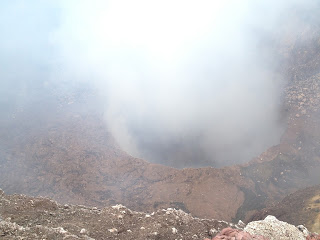On our last full day in Nicaragua, we went to several
locations. First, we went to the Mombacho Volcano. There, some of our group
decided to ride in the back of a truck and a few were in the inside of the
truck. The temperature drop hits you almost instantly. The wind starts to pick
up and the atmosphere gets thinner. Halfway up, we had some local coffee and
wow, was it delicious. I’m not a big fan of coffee but there was something
magical about the coffee we had. After, we hooped back onto the truck and
arrived at a higher area of Mombacho.
The following picture is of a crack through Mombacho, which created a tunnel. This is picture is when you look up.
Goofball self taking a picture of all of us! Notice the mist behind the rest of the gang.
When we finally made it to the top, it felt as though we left
Nicaragua. Everything was foggy and the winds were incredibly strong. I never
would have imagined being in a tropical rainforest so high up. It was amazing.
The echoes of the native monkeys, along with the screeches of birds allowed for
a magnificent orchestra of nature and mystery. We walked through a trail that
was about a mile and despite the fact that we couldn’t really see anything from
afar because of the thick clouds surrounding the top portions of Mombacho. As
we were walking through the forest, we kept running into this tour guide, who
happened to live in NY for a while and towards the end of our self guided tour
(he was guiding a couple), he introduced us to what I think was the coolest
thing ever. He brought us over to this hole and we put our hand in front of the
entrance of the hole and we could feel the warm steam from Mombacho. He then
took us to a bigger hole nearby. This hole was probably five feet in diameter
and with the amount of steam that came out, Dr. Sama could have dried her hair.
After the intangible experience, we were headed down Mombacho.
We all rode in the back of an industrial truck and with us
were a bunch of teenage Nicaraguans and few other Americans. Truthfully, I
enjoyed the consensus of this trip down being like a rollercoaster, so I chimed
in each time we went down a steep curve with a “WOOOOOOO!!” Along with the
excitement created, I was able to engage in conversation with the Nicaraguan
woman next to me. Out of all places, it turns out she lived in the same community
were Jon Thompson is located, Atolla. After a few questions about one another,
we finally parted ways and then we were off to Volcano Masaya. Before getting
to Masaya, we had a brief lunch and took a few pictures.
Masaya was breathtaking. The contrast between Mombacho and
Masaya are great. Masaya is an active volcano in Nicaragua and around Masaya:
molten rock and ash and Mombacho a tropical forest. Getting to an open creator of the volcano was
relatively easy. I was a bit weary by the signs advising cars to park facing
away from the volcano, in case Masaya were to erupt. The smoke here was very
visible and it’s a long drop to the lava, hidden away by the smoke and depth of
the crater. The sight was beyond surreal. A small wall with the exception of a
small area bordered some of the volcano; where you get the best view you could
possibly get of the seemingly endless hole. After a few pictures and goofball antics, we
made our way back to Managua.
Wonderful sight of the inside of the open creator.
Another picture of the open creator.
Dr. Sama and Co. running for their lives.
Before going back to the hotel for our last dinner in
Nicaragua, we made a stop in the old Managua, the Managua that was pretty much
destroyed by the earthquake back in 1972. One could see what now is the
parliament building. Before the earthquake, it was the national bank and was
the only building to fully withstand the earthquake. Along with its endurance,
it is also the tallest building in Managua, soaring 13 stories high. We drove
by and we ended up at the old church, which was also next to the national
assembly.
Building that survived the earthquake.
The old cathedral in Managua. It is blocked off and guarded due to the possibility of the cathedral collapsing.
Afterward, we went to Lake Managua, where we briefly stopped by in the beginning. We hung out for a bit, realizing that this was our last full day in Nicaragua.
























